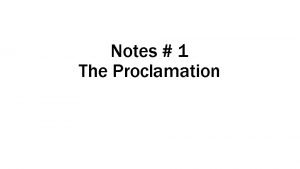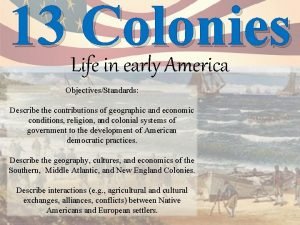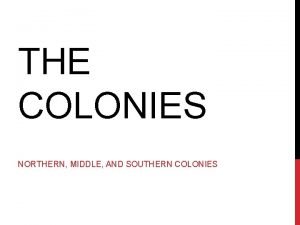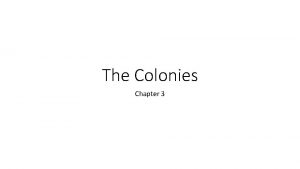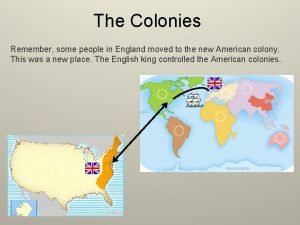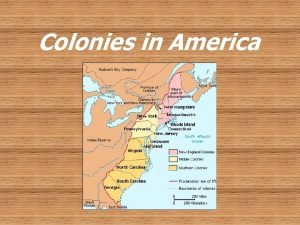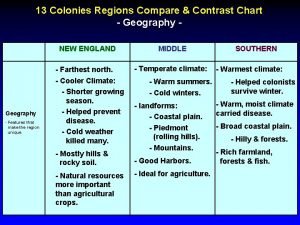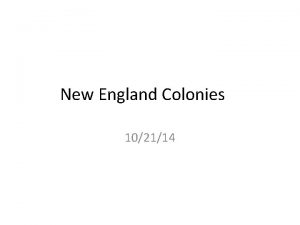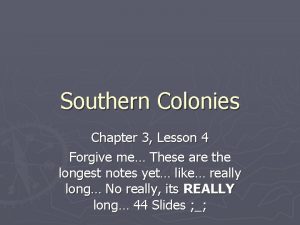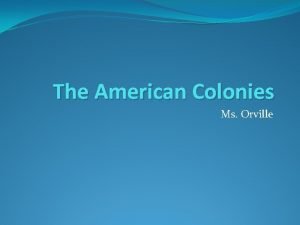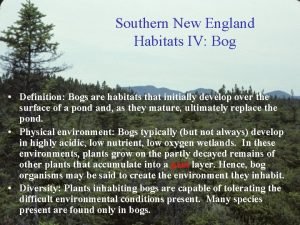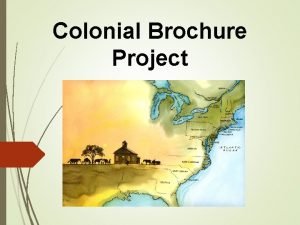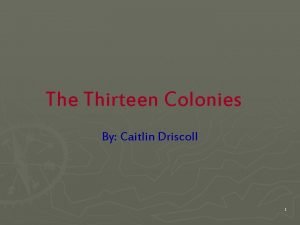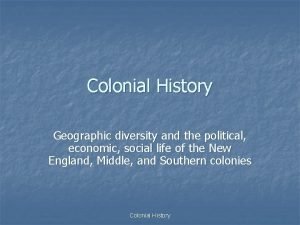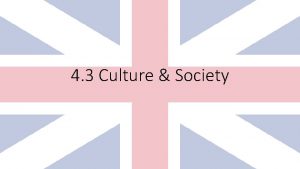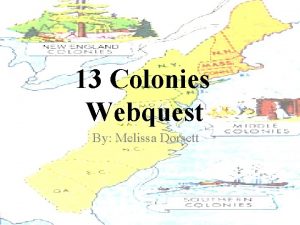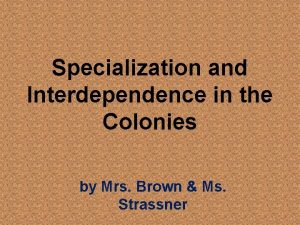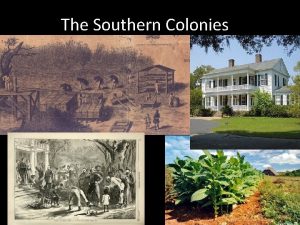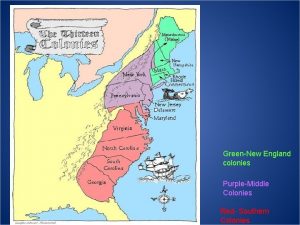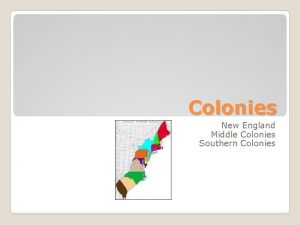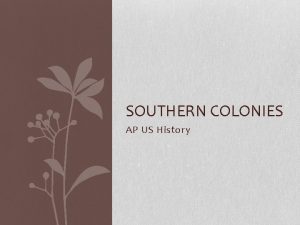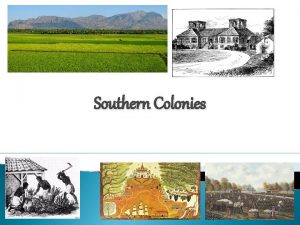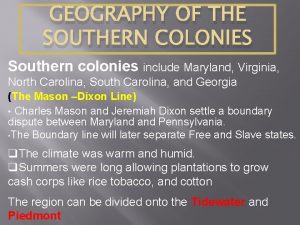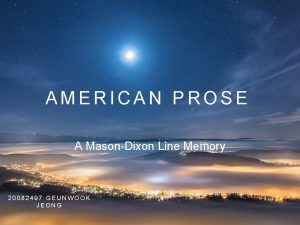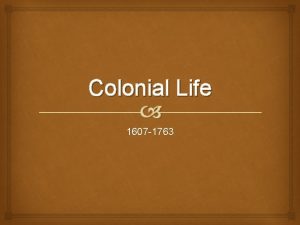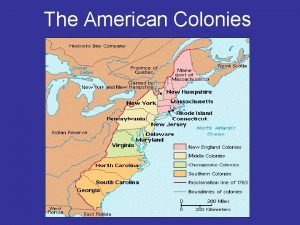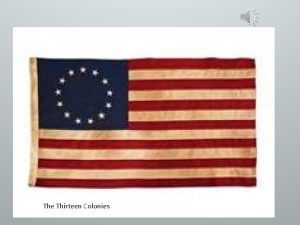The Southern Colonies The MasonDixon Line In 1763


















- Slides: 18

The Southern Colonies

The Mason-Dixon Line • In 1763, 2 English mathematicians began to survey the 244 -mile boundary between Pennsylvania and Maryland. – Charles Mason & Jeremiah Dixon • For 4 years, Mason and Dixon carefully laid stone markers on the border between the two colonies. – The sides facing Pennsylvania were inscribed with the letter ‘P’. – The sides facing Maryland were inscribed with the letter ‘M’.

The Mason-Dixon Line • In 1767, the two men completed the Mason-Dixon Line • It was more than just a boundary between Pennsylvania and Maryland. – It also divided the middle colonies from the southern colonies.

The Southern Colonies • • • Maryland Virginia North Carolina South Carolina Georgia

The Southern Colonies: Virginia • In 1606, the Virginia Company of London received a charger from King James I. • In the spring of 1607, 105 colonists arrived in Virginia. • They sailed into Chesapeake Bay and began building homes along the James River. • They named this tiny outpost Jamestown after their King, James I.

The Southern Colonies: Virginia • The colonists soon discovered that their colony was located in a swampy area. • The water was unhealthy and mosquitoes spread malaria – Many settlers suffered or died from disease.

The Southern Colonies: Virginia • Another major problem was starvation. • Captain John Smith helped save the colony. – He set up stern rules that forced colonists to work if they wished to eat. – He also visited nearby Indian villages to trade for food. • Problems in the colony soon resumed when John Smith returned to England in 1609.

The Southern Colonies: Virginia • The Jamestown economy finally got on a firm footing in 1612. • Colonists began growing tobacco – By 1620, England was importing more than 30, 000 pounds of tobacco a year. • Virginians had at last found a way to make their economy succeed.

A Tobacco Field

The Southern Colonies: Virginia • Representative Government – Male settlers were allowed to elect representatives. • These representatives met in an assembly called the House of Burgesses. – They made laws for the colony with the governor.

The Southern Colonies: Virginia • Women in Virginia – In 1619, the Virginia Company sent 100 women to Virginia to make the men more “settled” • The Virginia Company profited from this shipment because any man who found a wife from this shipment had to pay the company 150 pounds of tobacco.

The Southern Colonies: Virginia • Women in Virginia – Women did make the colony more settled. • Still life remained a daily struggle. – Women were not allowed to vote – Women had to make everything from scratch including: food, clothing, and medicines – Hard work and childbirth killed many at a young age.

The Southern Colonies: Maryland • In 1632, Sir George Calvert persuaded King Charles I to grant him land for a colony. • Calvert had ruined his career in Protestant England by becoming a Roman Catholic • Now he wanted to build a colony where Catholics could practice their religion freely.

The Southern Colonies: Maryland • Calvert names his colony Maryland – In honor of Queen Henrietta Maria, the King’s wife • Calvert died before the colony got underway • His son, Cecil, Lord Baltimore, went forward with the project.

The Southern Colonies: Maryland • Remembering the problems of Jamestown, the newcomers avoided swampy lowlands. • Maryland was valued for its many sources – Its bay was full of oysters, fish, and crabs • Across the bay, Virginians were growing tobacco for profit • Maryland settlers wanted to do this as well.

The Southern Colonies: Maryland • Government – As proprietor of the colony, Lord Baltimore appointed a governor and a council of advisers – He gave colonists a role in government by creating an elected assembly

The Southern Colonies: Maryland • Eager for settlers, Baltimore gave generous land grants to anyone who brought over servants, women, and children • Few women took advantage of this, including two sisters, Margaret and Mary Brent, who arrived with 9 male servants – In time they set up 2 plantations of 1000 acres each

The Southern Colonies: Maryland • Religious Toleration – Lord Baltimore welcomed Protestants as well as Catholics to his colony – Later he feared that Protestants might try to take away the Catholics’ rights to worship freely – In 1649, he asked the assembly to pass an Act of Toleration – This provided religious freedom for all Christians, this freedom did not extend to Jewish.
 Proclamation line of 1763
Proclamation line of 1763 Economy of middle colonies
Economy of middle colonies Southern colonies
Southern colonies Southern colonies
Southern colonies 13 colonies new england middle and southern
13 colonies new england middle and southern Is maryland in new england
Is maryland in new england Colonial regions chart
Colonial regions chart New england, middle and southern colonies comparison chart
New england, middle and southern colonies comparison chart Chapter 3 lesson 4 the southern colonies
Chapter 3 lesson 4 the southern colonies New england mid atlantic and southern colonies
New england mid atlantic and southern colonies Southern colonies
Southern colonies Southern colonies definition
Southern colonies definition Religion southern colonies
Religion southern colonies The middle colonies brochure
The middle colonies brochure Southern colonies
Southern colonies Southern colonies geography
Southern colonies geography Southern colonies society/culture
Southern colonies society/culture 13 colonies webquest
13 colonies webquest Southern colonies specialization
Southern colonies specialization
